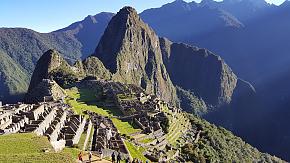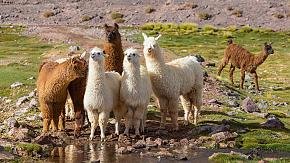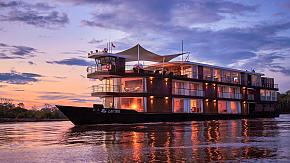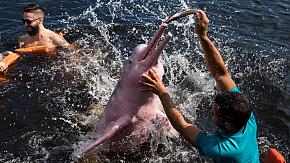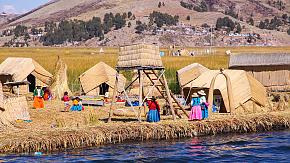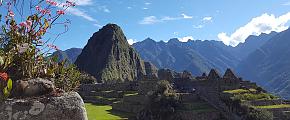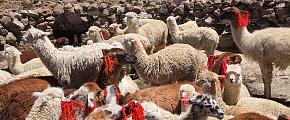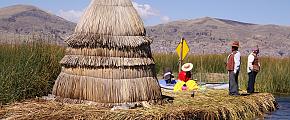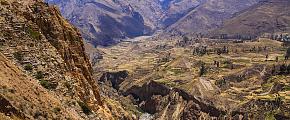Inca Trail Hiking Guide: Best Time, Route Selection & Tips
Take an unforgettable Inca Trail hiking with our comprehensive guide to packing list, best time, route selection, and costs. Start your Peru tour, where you see ancient ruins and stunning scenery. Let us soak in the rich culture and natural beauty of the Andes!
Why to Hike the Inca Trail
With a 600-year history, only 500 permits are available each year, 42 kilometers long, highest altitude of 4,200 meters, Inca Trail hiking is a dual test of physical strength and willpower.
It is the only route in Peru that traverses four major ecosystems - the rainforest, cloud forest, Andean peaks, and dry forest. You will experience various climate zones and enjoy the magnificent views of cloud seas, waterfalls, as well as Inca ruins along the way, and might even encounter rare animals such as the Andean condor and wild alpacas.
The most exciting moment is when you witness Machu Picchu awakening in the morning light, which is known as the "Lost City of the Incas", listed as a World Heritage Site by UNESCO in 1983 and named one of the New Seven Wonders of the World in 2007.
This is not an ordinary hike, but a journey to refine a more authentic self through challenges. Are you ready to meet the stronger version of yourself? The Inca Trail awaits true heroes.
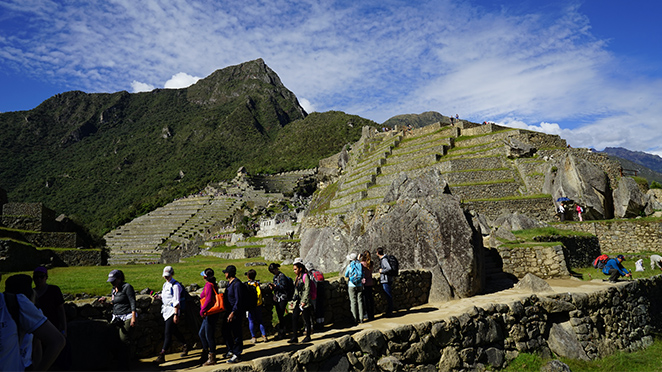 Hike the Inca Trail
Hike the Inca Trail
Best Time for Inca Trail Hiking
The best time for Inca Trail hiking is during Peru's dry season (May to October), with mostly sunny days. In these months, there are lively festivities such as Qoyllur Rit'i, Feast of Corpus Christi, and Inti Raymi, to enjoy the rich cultural atmosphere. Along the way, you'll pass away the rainforest, cloud forest, Andean peaks, and dry forest. On clear days, the snow-capped peaks in the distance are looking at you. Eventually, you can reach the Sun Gate of Machu Picchu, embrace the world's vastness, and enjoy the starry night sky.
Although the rainy season (November to April) has possible showers, you can still expect its unique charm. There are fewer tourists to offer you a peaceful hiking experience, waterfalls are abundant, and the misty valleys are magical.
Note:
- The Inca Trail hiking requires a permit to enter and is in high demand. The permit (approx. $ 90) is linked to your passport and can be ordered from the official website. To ensure your spot and availability, it's recommended to book a permit a few months in advance of your planned visit.
- It's worth noting that this trail is closed in February. If you are planning your hiking in the rainy season (November-March), bringing rain gear and non-slippers is important, and moist land and air will give a special experience.
Crowd & Cost
As one of the most famous hiking trails in the world, the Inca trail hiking is very popular and crowded most of the time, especially during high season. In high season, the Inca trail restricts a maximum of 500 people to enter each day, including 200 trekkers, 300 porters, guides, and cooks. Though with a limit of permits, the trail is still busy. To ensure your experience, it's recommended to book your trip to Peru 6 months in advance.
The prices of your Inca Trail hiking may vary at different times of the year. A 4-day/3-night classic Inca trail tour costs approximately $1000 to $1800 depending on your demand for accommodation and transportation. It can cost more for a luxury journey. For example of a 4-star tour, daily expenses range from $250 to $280 per person per day (based on two persons sharing one room) in shoulder season.
If you are still confused about these things, feel free to contact Odynovo or send an email to [email protected], our travel expert will be happy to help.
Accommodation & Rest
There are no hotels on this trail, and your available accommodation is tents and sleeping bags in the wild. To ensure your comfort, it's recommended to bring them by yourself. Since each campsite has squat toilets, get your own toilet paper and hand sanitizer to at least keep you clean. Some campsites have basic shower facilities, and a simple scrub with a wet paper towel may give a comfortable experience. In addition, there is no internet on this trail, but you will have plenty of time to chat and soak up the quiet of the night.
Tips: According to professional experience, I suggest staying in Aguas Calientes for 1-2 days in advance. So that you can accomalize peru's altitude sickness, and make your trip smooth.
How to Choose the Best Route of Inca Trail
There are three routes of Inca Trail hiking that vary due to their length for detail, offering the opportunity to choose based on your preferences. Generally speaking, the landscapes of Machu Picchu and the main sites like Ollantaytambo and Intipunku still appear before your eyes.
The Easiest Route: 2-Day Inca Trail Tour
- Difficulty: Easy
-
Highest Altitude: 2800 Meters (9186 feet)
 2-Day Inca Trail Hiking Map
2-Day Inca Trail Hiking Map
If you're interested in exploring historical culture and trying an easy hike, choose a fascinating 2-day expedition, approximately 12 km with 5 hours a day of walking. Starting from Cusco, witness the stunning sunrise over the Sacred Valley before exploring the ancient ruins of Ollantaytambo. Boarding the train at KM 104 Station, anticipation builds for the hike ahead.
This trail unfolds with visits to archaeological wonders like Chachabamba and the terraces of Winay Winay Wayna. Various orchids and wildlife make the ruins lively. Reach Intipunku, the highest point in this route at 2750 meters, for a breathtaking view, then journey on to the Sanctuary of Machu Picchu. After that, you'll return with a train ride to Ollantaytambo.
Or you can take a train from Ollantaytambo to Aguas Calientes, then hike to Machu Picchu, pass through Intipunku, Winay Wayna, and Chachabamba, return to KM 104 Station and train to Ollantaytambo.
Recommend for Family: 2-Day Lares + 2-Day Inca Trail
- Difficulty: Moderate
-
Highest Altitude: 4600 Meters (15,092 feet)
 2-Day Lares Trek + 2-Day Inca Trail Map
2-Day Lares Trek + 2-Day Inca Trail Map
It's recommended for people with kids to explore Lares and hike the Inca Trail because you'll generally visit more attractions and deepen your understanding of their culture in a limited time.
Your hiking tour will begin from Cusco. Enjoy the Lares hot spring, visit communities and local events in Huacawasi, and hike to the Ipsaycocha Pass (4,600 meters) from where the chain of snowy peaks will be appreciated. Then continue your journey from Patacancha to Pumamarka, hike to the ancient ruins of Ollantaytambo, and train to KM 104 Station, where you'll start your Inca trail hiking. After passing through Chachabamba Ruins, the archaeological center of Winay Wayna, you'll arrive by Intipunku, and visit the Machu Picchu Sanctuary. And you'll return by train.
Tips: The Inca Trail has age requirements, for example, children over 12 years old are recommended to participate in the hike. If you want to learn more about family tours, click and read How to Plan a Family Trip to Peru.
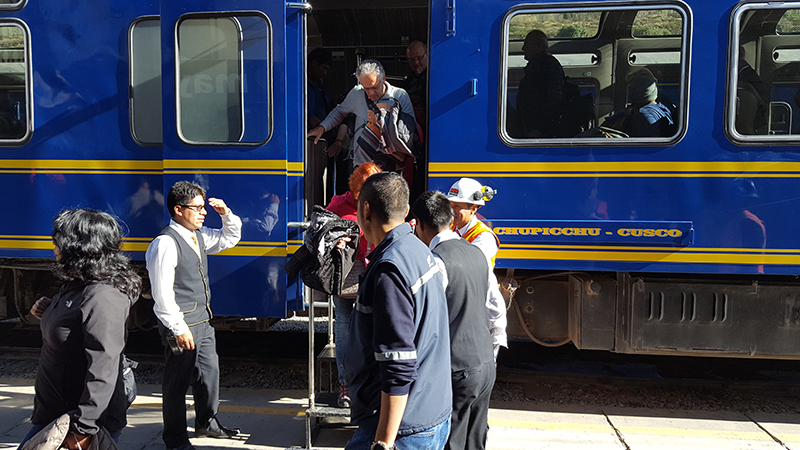 Train Between Cusco and Machu Picchu
Train Between Cusco and Machu Picchu
Best for Hiking Lovers: 4-Day Inca Trail Tour
- Difficulty: Chanllenging
-
Highest Altitude: 4200 Meters (13,828 feet)
 4-Day Inca Trail Hiking Map
4-Day Inca Trail Hiking Map
The recommended route for hiking lovers is the classic Inca Trail of 4 days, approximately 44 km with 7 hours a day of walking. Starting from Cusco, you'll explore the ancient Ollantartambo before admiring the terraces, canals, and squares of the Llactapata Ruins. Then pass through the highest point Warmihuanuscca, the archaeological site Sayamarca, platforms and aqueducts of the city above the clouds Phuyupatamarca, the ancient Intipunku, and Machu Picchu Sanctuary. Eventually, you'll return by train from Aguas Calientes to Ollantaytambo, and go back to Cusco.
If you're interested in their culture, try to experience overnight and food with the locals, learn customs, and their culture and depart the following day to Inca Trail Km 82, which is free, but it must be booked in advance.
Or you can take a train from Cusco to Aguas Calientes and go back along this route.
More Tips for Hiking Inca Trail
Accompanied by Guide and Porter
The official established that accompanied by a guide and a porter is necessary for Inca Trail hiking. The guide can not only provide cultural and historical background interpretation but also ensure your safety and comply with local management regulations.
The porter is mainly responsible for transporting equipment, food, and other necessities, usually carries luggage weighing a maximum of 20kgs, and can also provide basic services such as setting up tents and preparing meals, to create a more comfortable camping environment for you.
Additional Costs With Cash
Your prepaid tour covers most costs, but it's wise to carry some small notes and coins because there are some expenses you will need to pay with cash in Peruvien sol or dollar, such as snacks and drinks from stall owners, toilet entrance fees (usually 0.5 USD at Machu Picchu), tips for porters and guides. When you have completed the Inca Trail hiking, you may want to tip them for their diligence. The recommended approximate tip per trekker is 32 USD for the porter and cook (who will be responsible for splitting the tip), 9 USD for the tour leader, and 5 USD for the assistant guide.
Packing List
Packing light and smart for hiking is important. Here's a detailed packing list:
Important Items: Valid identification documents, passport, and hiking permits.
Two Backpacks: A large backpack (the porter will carry them) with a tent, sleeping bag, and thermal underwear; a small backpack with you to carry ID card, flashlight, gloves, scarves, and other items.
Dress in Layer: A moisture-wicking base layer, a warm middle layer, and a waterproof outer layer.
Comfortable Accessories: Sturdy hiking boots and hiking poles.
Rain and Sun Protection: A hat, sunglasses, and sunscreen.
Personal Care: Insect repellent, basic toiletries (toothbrush, toothpaste, biodegradable soap, etc.), hand sanitizer or wipes.
Altitude Sickness Prevention: Consult your doctor early to bring some medications, energized with water to keep hydrated.
What Our Clients Say
Explore the latest verified reviews of Odynovo's travel services on Tripadvisor, Google, Trustpilot, Product Review and more trusted platforms.

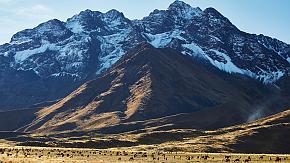
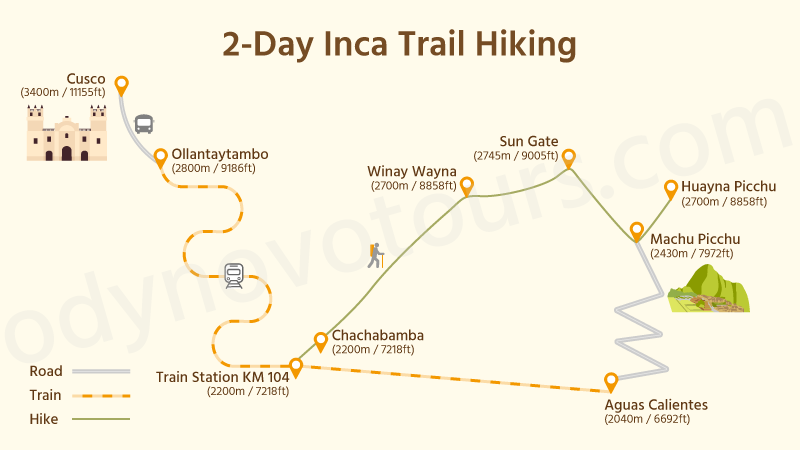 2-Day Inca Trail Hiking Map
2-Day Inca Trail Hiking Map
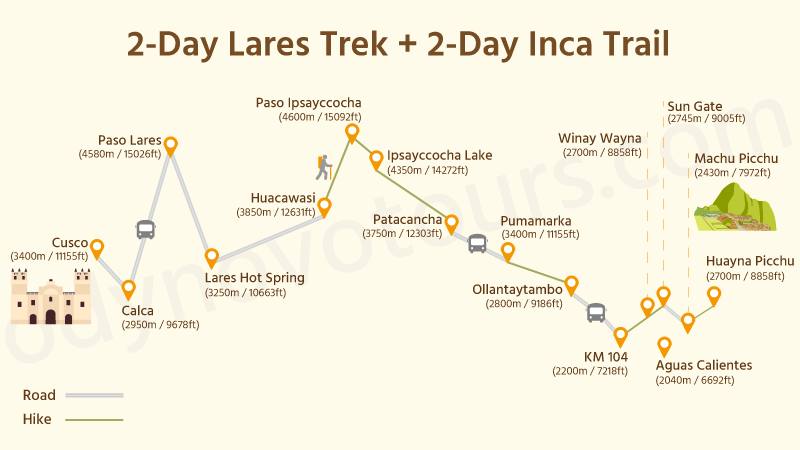 2-Day Lares Trek + 2-Day Inca Trail Map
2-Day Lares Trek + 2-Day Inca Trail Map
 4-Day Inca Trail Hiking Map
4-Day Inca Trail Hiking Map
